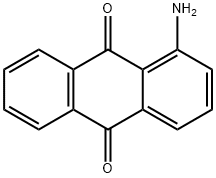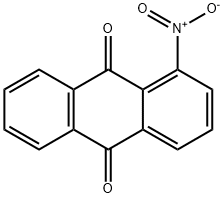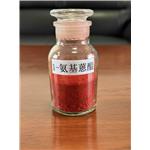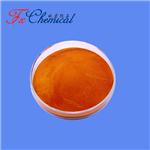Description
Anthraquinone dyes are the second largest class of dyes after azo dyes, and 1-aminoanthraquinone is an important intermediate for the synthesis of anthraquinone dyes. It is the main raw materials of amino acid and pyrazole anthraquinone occupy an extremely important position in the dye industry.
Chemical Properties
deep brown crystalline powder. Soluble in hot nitrobenzene, toluene, xylene, ether, acetic acid, chloroform, benzene, slightly soluble in cold ethanol, insoluble in water.
Uses
1-Aminoanthraquinone is the most important intermediate for manufacturing acid, reactive, disperse, and vat dyes.
Preparation
1-Aminoanthraquinone (1-AAQ) is synthesized by the condensation of 2-substituted benzoic acid and xylene to yield 2-substituted-dimethylbenzophenone, subsequent oxidation of the methyl groups, ring closure to form a 1-substituted anthraquinone carboxylic acid, replacement of the 1-substituent with ammonia, and decarboxylation.
Application
1-Aminoanthraquinone has the ability to increase the solubility of anthraquinone derivatives in supercritical carbon dioxide. It is widely used in the preparation of various anthraquinone dyes. It also bridges Pt nanoparticles on carbon nanotubes as efficient electrocatalysts.
Hazard
Toxicity studies showed histopathological changes in the kidneys and spleen, loss of breastfeeding behaviour, decreased pup survival on day 4 after birth, repeated doses and reproductive toxicity less than 40 mg/kg/day (lowest tested dose) of NOAEL.
No adverse effects on reproductive parameters or teratogenicity were observed. caused excitability, weight loss, and liver and kidney changes in an inhalation study in rats; orthocytotic anaemia, weight loss, and organ changes (liver, spleen and heart) in a 2-week oral study in guinea pigs; and was not irritating to the skin or eyes of rabbits.
Biochem/physiol Actions
1-Aminoanthraquinone has the ability to increase the solubility of derivatives of anthraquinone in supercritical carbon dioxide.
Safety Profile
Moderately toxic by intraperitoneal route. An eye irritant. Questionable carcinogen with experimental tumorigenic data. Mutation data reported. When heated to decomposition it emits toxic NO,. See also AMINES
Synthesis
Anthraquinone is sulfonated with nicotinic sulfuric acid in the presence of a small amount of mercury salt to generate anthraquinone-1-sulfonic acid, which is then neutralized with potassium hydroxide to form anthraquinone sulfonic acid potassium salt. Under high temperature and high pressure, ammonia and anthraquinone sulfonic acid potassium The salt action generates 1-aminoanthraquinone, and the generated sulfite reacts with the product again and the quality of the product decreases. Therefore, nitrobenzene sulfonate is usually used as an oxidant to oxidize sulfite to sulfate, which itself is reduced to m-aminobenzenesulfonic acid.







